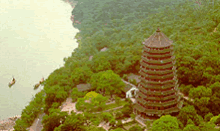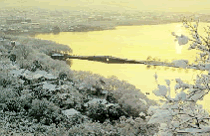Zhejiang
 Zhejiang Province lies on the southeast coast in East China and is well-known for its picturesque sceneries like green hills and clear waters. Famous as Fish and Rice Land, Zhe Jiang is a district with numerous cultural treasures, and is a dreamland for tourists.
Zhejiang Province lies on the southeast coast in East China and is well-known for its picturesque sceneries like green hills and clear waters. Famous as Fish and Rice Land, Zhe Jiang is a district with numerous cultural treasures, and is a dreamland for tourists.
The top ten tourist attractions in Zhejiang are West Lake, Putou Mountain, Yaolin Wonderland, Yandang Mountain, Thousand-Isle Lake, Lingyin Monastery, Brook Mouth, Guoqing Temple, Shiliang Mountain Scenic Area, Mugan Mountain and the Qiantang River Tidal Bore.
Zhejiang is one of the important tourism places in China, famous for its natural beauty and historical and cultural heritages. Zhe Jiang is located on the low reaches of Yangtze Delta area in southeast China, to the south of Shanghai and Jiangsu, north of Fujian and Jiangxi, and east of Anhui
Zhe Jiang is of subtropical monsoon climate, with distinctive four seasons and mild atmosphere and favorable geographical positions and natural conditions. It covers a total area of over 100,000 square kilometers, with a population of 44.22 million. Its capital city is Hang Zhou, one of the seven ancient capitals, famous for its historical and cultural heritages.
Zhe Jiang is one of the cradles of Chinese civilization. The human being had lived and prospered in this land 4700 years ago, which is called "Liangzhu Culture".Zhe Jiang is noted as Fish and Rice Land and Silk land. It also produces high quality tea, bamboo and bamboo products.
Recommended Scenic Spots
West Lake
Lying on the west edge of Hangzhou city, West Lake is the symbol of Hangzhou as well as one of the most beautiful sights in China. Early in the Song dynasty, the famous poet Su Shi compared the lake to Xizi, a Chinese Cleopatra: "Ripping water shimmering on sunny day; Misty mountains wonder in the rain; Plain or gaily decked out like Xizi; the West Lake is always alluring". So the Lake is also known as Xizi Lake. With an area of 6 sq km and a circumference of 15km (9 miles), West Lake, surrounded in three sides by rolling wooded hills, has captivated countless visitors for centuries.
6 sq km and a circumference of 15km (9 miles), West Lake, surrounded in three sides by rolling wooded hills, has captivated countless visitors for centuries.
Legend has it that West Lake was originally a jewel fallen from heaven. Actually it is a lagoon formed as a result of natural changes and human efforts. Ten thousand years ago, the lake was much larger than its present surface of 5.6 square kilometers. Later, as silt accumulated and weeds overgrew, the lake shrank in size. The present West Lake consists of 5 sections, namely the Outer Lake, North Inner Lake, Yuehu Lake, West Inner Lake and Lesser South Lake.
The beauty of the West Lake lies in a lingering charm that survives the change of seasons in a year, of hours in a day, and of different weathers. In order to display the best beautiful aspect of West Lake, 10 sights were named by people as the most beautiful, which include Melting Snow at Broken Bridge, Spring Dawn at Sudi Causeway, Sunset Glow over Leifeng Hill, Lotus in the Breeze at Crooked Courtyard, Autumn Moon on Calm Lake, Listening to Orioles Singing in the Willows, Viewing Fish at Flowers Harbor, Evening Bell at Nanping Hill, Three Pools Mirroring the Moon, Twin Peaks Piercing the Clouds.
Among these sights, Spring Dawn at Sudi Causeway tops the list. Built with silt in 1089 when Su Dongpo supervised the dredging of the lake, Sudi Causeway extends 2.8 kilometers with grass and peach and willow trees planted along its entire length. The bell rings at dawn as the moon is sinking in the west, weeping willows along the embankment sway in the morning haze, the lake blends in perfect harmony with the surrounding landscape like a roll of ink-and-water painting.
Viewing Fish at Flowers Harbor is to the west of the 5th and 6th bridges on the Sudi Causeway. Buildings erected in Song times surround a pond in which golden carp are raised. Here visitors can watch fish swimming in the water and flowers in blossom on land.
Possessing such a fairyland in this city, no wonder Hangzhou enjoys the fame "There is a paradise in heaven and Suzhou and Hangzhou on earth."
Mt. Mogan

Part of the Tianmu Mountains, Mogan Mountain is situated in Deqing County, Zhejiang Province, sixty kilometres away from the city of Hangzhou. Legend has it that this is the place where Moye and his wife Ganjiang cast their famous swords during the last years of the Spring and Autumn Period (770-476B.C.). Hence the name Mogan Mountain.
In the height of summer it is as chilly and crisp as in autumn on the quiet, cool Mogan Mountain. Here the spring water is clear as crystal year round. The shades of the tall slender bamboos look like a sea of green. Ancient pines and cypresses tower into the skies. Climbing up the Qifeng Peak to enjoy a panoramic view, one sees the vast expanse of a mist-shrouded Taihu Lake in the east, and a color silk belt of the Qiantang River in the south. At the first grey of dawn the rising sun suddenly emerges between the clouds and waters, offering a truly magnificent view. At the Sword Pool tourists watch the cliffside waterfall sweeping down in white sheets, sending misty sprays flying in every direction. Furthermore, sightseers are struck by the grotesqueness of Shiqiao Hill, the grandeur of Shimenka, the tranquillity of Mogan Ridge, and the beauty of Ludangxiuse (Picturesque View of the Reed Marshes) and Yinshandongtian (Exceptional Charm of the Foliage shaded Hill) - so much so that they find it hard to tear themselves away from these scenic places. Wujitou (Roof Ridge Edge), in particular, is a secluded spot tastefully laid out, with pure and fresh air. Indeed, here alone can one truly appreciate these lines: "The wood seems quieter with the noise of cicadas; the mountain is more serene with the chirping of birds."
Mogan Mountain is famous for its four features: - coolness, verdancy, clearness, and tranquility - and three peculiarities -- bamboos, spring water, and clouds. No wonder it is called one of the four best summer resorts in China, the other three being Lushan Mountain, Beidaihe, and Jigong Mountain













No comments:
Post a Comment